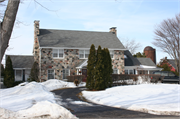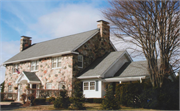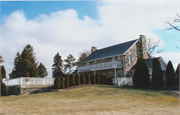Property Record
W272 S2137 COUNTY HIGHWAY TT / MERRILL HILLS RD
Architecture and History Inventory
| Historic Name: | Ward Brown Farmhouse |
|---|---|
| Other Name: | |
| Contributing: | |
| Reference Number: | 176561 |
| Location (Address): | W272 S2137 COUNTY HIGHWAY TT / MERRILL HILLS RD |
|---|---|
| County: | Waukesha |
| City: | |
| Township/Village: | Waukesha |
| Unincorporated Community: | |
| Town: | 6 |
| Range: | 19 |
| Direction: | E |
| Section: | 6 |
| Quarter Section: | SE |
| Quarter/Quarter Section: | NE |
| Year Built: | 1963 |
|---|---|
| Additions: | |
| Survey Date: | 2011 |
| Historic Use: | house |
| Architectural Style: | Colonial Revival/Georgian Revival |
| Structural System: | |
| Wall Material: | Fieldstone |
| Architect: | |
| Other Buildings On Site: | |
| Demolished?: | No |
| Demolished Date: |
| National/State Register Listing Name: | Not listed |
|---|---|
| National Register Listing Date: | |
| State Register Listing Date: |
| Additional Information: | A 'site file' exists for this property. It contains additional information such as correspondence, newspaper clippings, or historical information. It is a public record and may be viewed in person at the Wisconsin Historical Society, State Historic Preservation Office. 2011- "The farmstead is defined by a highly intact, large, two-story, Colonial Revival-style house clad with a fieldstone veneer. The sidegabled roof carries fieldstone wall chimneys at each end. The main (east) farcade features a central entrance protected by an open gabled entry porch. The porch roof is supported by a pair oflonic columns, as well as Ionic pilasters against the main wall. A pair of eight-over-twelve, double-hung sashes flank the entrance on the first floor, while three paired sets of six-over-six, double-hung sashes pierce the second floor. A one-story, gabled stucco-covered wing extends from the south endwall, while two wings telescope with each other off the north endwall. Both of these wings on the north endwall are gabled and covered with stucco. The farmstead is dominated by a large bam complex (AHI# 176581) that is centered on a circa-1890s gabled Bank bam that is clad with vertical boards. A board-and-batten covered wing is attached to the bam's north end with a short, fieldstone silo tucked in the juncture of those two elements. A taller, tile silo and a shed-roof block are attached to the south end. The property also features a circa-1960s frame garage (AHI# 176601), stone driveway markers (AHI# 176641) and a carriage house/chicken coop that was converted into a farm employee house in the 1950s (AHI# 176621). A farmstead at this location first appeared on plat maps in 1873 with a 210-acre parcel owned by C.G. Williams. By 1891, Frederick Gerrits owned the property, which was known as the "Burr Oak Farm." The 1891 plat also indicated that Gerrits was a breeder of Shorthomed cattle and Poland China hogs in addition to his dairy operation. The Gerrits family maintained ownership for an extended period with Edward Gerrits cited as owner until at least 1914. Edward Gerrits was born in Wisconsin on 11 September 1855. He married Amelia Granger and the couple had three children. Gerrits died in California on 24 January 1950. By the early 1920s, the farm was owned by the Krummenacher Brothers, who maintained the parcel until1941. From 1941 to 1958, the property was owned by Richard Hallstrom, who used the property for his registered Jersey cattle herd. Hallstrom was active in the state Jersey association and his livestock won numerous state and national awards. Ward Brown owned the property in the 1960s and 1970s and built the subject farmhouse in 1963. The property is currently a residential acreage." -"Waukesha Bypass, CTH TT: STH 59 (south) to I-94 (north)", WisDOT#2788-01-00, Prepared by Heritage Research, Ltd., (2011). Historic tax rolls indicate C.G. Williams in 1867 owned nearly the entire south half of section 6 in the Town of Waukesha. He sold the parcel to George Love by 1880 to George Love, who then sold 210 acres of it to Frederick W. (or M.) Gerrits by 1890 where it became known as the Burr Oak Farm. An 1891 plat noted that Gerrits operated a dairy and stock farm and was a breeder of Shorthorned Cattle and Poland China hogs. A German immigrant, Gerrits died in 1894 and the farm remained in the family with Edward Gerrits taking ownership. Edward Gerrits was born in September 1855 in Wisconsin. He and his wife Amelia had three children -- Florence (b. 1886), Warren (b. 1888) and Iva (b. 1890). Sometime between 1914 and 1920, Gerrits sold the farm to the Krummenacher family and moved to Mississippi to work as a farm manager. He died in 1950 in Orange County, California. The Krummenacher family were Swiss immigrants who consisted of siblings Joseph, Frederick, Alfred, Rose, Paul and Charles and their mother, Mary. They arrived in the United States in 1903. In 1920, the whole family is listed in the census as living at the farm, however, while Joseph's, Alfred's and Charles' occupation were listed as farmer and Rose and her mother as keeping house, Paul's occupation was that of watchmaker and Frederick was that of teacher. By 1930, only Joseph, Alfred, Rose and Paul remained at the farmstead, which was listed on plat maps as owned by the Krummenacher Brothers. Paul would eventually depart to operate a jewelry store in Waukesha for several decades. The remaining siblings did not marry and sold the farm to Richard W. Hallstrom in March 1941. Richard W. Hallstrom was born in 1920 to Richard and Julia Hallstrom and grew up in Milwaukee and Whitefish Bay. The elder Hallstrom was the president of the A. George Schulz Company, which made paper boxes, cartons and containers. The younger Hallstrom initially worked for architect George Spinti and after receiving an inheritance decided to buy a farm even though the family had no agricultural background. The farm came with twenty Jersey cattle. In 1950, Hallstrom joined the Wisconsin Jersey Boosters and increased his farming activity significantly. In that year, he hosted a picnic of Milwaukee Farmers, Inc., which was a group of Milwaukee businessmen who owned farms, and sales of registered Jersey dairy cattle first appeared in the local newspaper. In 1951, Hallstrom visited the Isle of Jersey and purchased several of the animals; he also showed Jerseys at the Waukesha County and Wisconsin State fairs. The next year, he returned to the Isle and imported more twenty-five Jerseys, which raised his herd to ninety. He also hired as farm manager, Owen Bowman, who was highly experienced with the breed. By 1953, Hallstrom's Jersey herd was well established and he started to take out sales advertisements in the Journal of the Wisconsin Jersey Booster, which was the quarterly publication of the statewide organization. He also placed eighth with a senior yearling heifer at the 1953 National Dairy Congress in Waterloo, Iowa, and third at the International Dairy Show in Chicago. The next year, Hallstrom is first listed in the Jersey Performance Register, which is the national list of all registered Jersey cattle as well as their owners. Many Jersey farmers subjected their herds to inspection by the national organization and those herds that graded 84 or above were listed in the Register. In 1954, Hallstrom's herd featured 52 rated Jerseys that provided for an 87.12 rating, which was in the middle of the pack with regard to the several hundred herds listed. Hallstrom's herd would remain in this category in the same general range throughout his tenure at the farmstead. Hallstrom continued to show cattle in 1954 and 1955 and became the director of Parish One (Southeast Wisconsin) of the Wisconsin Jersey Boosters from 1954-1955; however, advertisements by Hallstrom in the Wisconsin Jersey Booster stopped in 1957. Also in 1957, Hallstrom won the National Jersey Jug at the Ohio State Fair for one of his animals, which was considered to be one of the most prestigious honors for those who own the breed. However, in 1958, Hallstrom moved with his Jersey herd to Keene, Virginia, and bought a large historic farm known as Plain Dealing. He cited as reasons for the move difficulties in farming due to suburbanization and high property taxes. Hallstrom remained active in the Jersey cattle business until at least 1965, after which time he was no longer mentioned in the Jersey Performance Register. Hallstrom sold the farm to Ward 'Doc' Brown. Brown was born on 4 January 1922 in Bishop, Texas, to Everett and Lillie Brown. After obtaining a chemistry degree from the University of Texas, Brown graduated from the Marquette University Medical School. He began his practice at Waukesha Memorial Hospital in 1948 and married Marjorie Wiles that same year. In the 1950s, Brown also started what would become a substantial farming operation known as Charnwood Farms. At the farm's peak, Brown owned or rented 2,500 acres and employed fourteen people. He raised primarily cattle, horses and field crops. The Brown residence was completely destroyed by fire in October 1962 (no one was injured except for the loss of the family dog) and was replaced with the subject house by 1964. Its stone veneer was picked from the surrounding fields. It is believed that the basement was constructed as an emergency shelter as a result of family trauma from the fire, as well as preparedness for nuclear war. Brown continued farming operations into the mid 1970s and then gradually sold much of his land to developers. |
|---|---|
| Bibliographic References: | Plats, taxes, "Journal of the Wisconsin Jersey Booster," "Hallstrom Farm to be Sold," Waukesha Freeman, 18 September 1958, interview with retired farmhand. Waukesha Bypass Architecture/History Survey, WisDOT #2788-01-00, Prepared by Heritage Research (2011). |
| Wisconsin Architecture and History Inventory, State Historic Preservation Office, Wisconsin Historical Society, Madison, Wisconsin |





